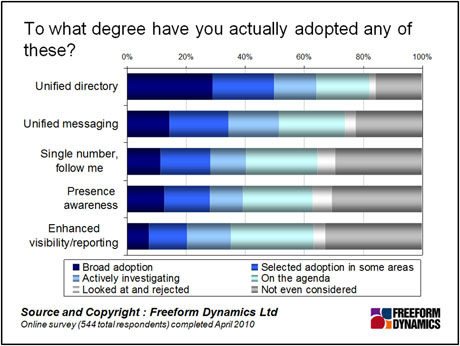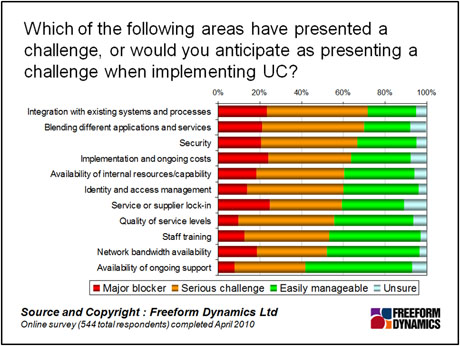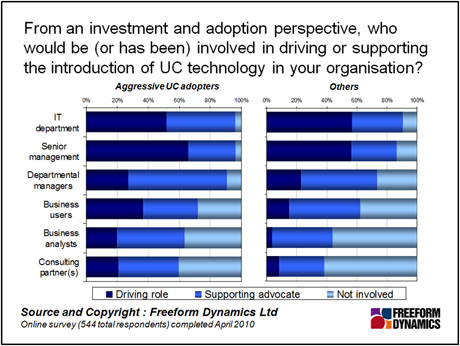It seems that Unified Communications (UC) has at last started to move beyond the ‘what is it’ stage and hit the mainstream world of real users with real implementations and real experiences.
As we found in our poll (full report available here) at the end of last year, which looked at advanced business communications in the workplace, when we talked about the different components of UC, such as Unified Directory (UD) or Unified Messaging (UM), many have already either implemented these or have them on the agenda to some degree, with only a very small proportion actually having rejected them completely.

This is actually a pretty positive picture, and one that gives companies more confidence when thinking about taking the UC plunge. Implementing UC is a significant initiative, however, and awareness of potential challenges is a critical part of the planning process. If we look at the challenges that Reg readers have either experienced or anticipate, as shown in the chart below, we can learn a lot.

The initial suggestion from this picture, as indicated by the red and orange portion of the bars, is that many businesses see UC implementations as weighed down with quite serious challenges, particularly around integration, security, cost management and a fear of vendor lock in. But on a positive note, a not insignificant proportion of Reg readers say that, in fact these challenges are easily manageable, as indicated by the green portion of the bars. So what can we glean from this?
By analysing this further, we have found that the challenges are lessened to some degree for those users who have taken a more aggressive UC adoption approach, embracing a wider set of components – unified directory, unified messaging and presence for example. Equally those implementing on a wider basis across their company also see benefits. Together these suggest that taking a more all encompassing and joined up approach from the outset, while not necessarily making the UC journey hassle free, can make it a little easier. If we think about this, this is intuitive. We would expect a properly designed and packaged UC solution to lead to fewer integration challenges than with a piecemeal/DIY approach.
It is also notable that those businesses that have embraced UC more aggressively have made certain of more involvement of stakeholders from across the business in driving and supporting initiatives around UC. This makes absolute sense, as the success of strategic implementations of this nature is closely linked to the level of support across the entire business. And of course, implementations which pull in a broader range of stakeholders are much more likely to be properly specified.
Evidence of this more all-inclusive approach is illustrated in the chart below.

From this, we can suggest that businesses which involve a broader reach of stakeholders while introducing UC will be able to better manage the challenges that exist around implementation. Beyond this, however, we would anticipate that a successful, stress-reduced installation is based on a very close relationship between the business and the solutions provider, which takes into account not just the UC inventory, but will play close attention to the business needs, and the impact that UC will have across the business. Working out just what these might be is generally better from those with battle scars and prior experience.
This doesn’t mean that companies should fall in with the vendor hype, and allow themselves to be led down a path that is ultimately not right for them. Typical feedback from Reg readers around what facilitated a UC implementation focusses around involvement of key technical leads during planning and implementation with clear migration plans and slow, well planned integration steps. Opting for open standards as far as possible and closely defining service level agreements (SLAs) that take into account company key performance indicators (KPIs) are also likely to reap rewards. Ensuring that the systems are easy to use, configure and manage is also considered a priority, and should surprise no one.